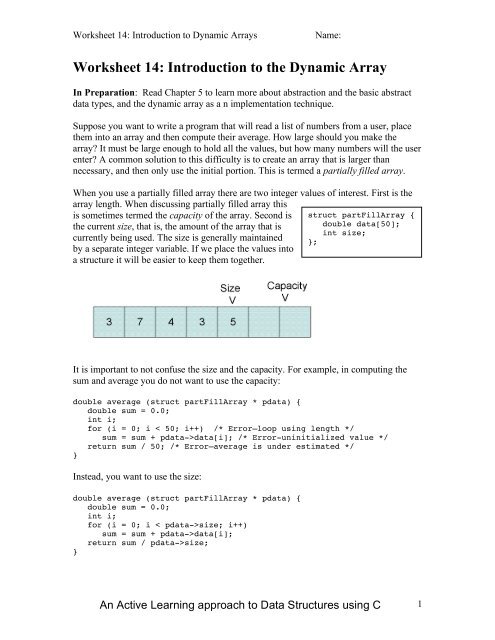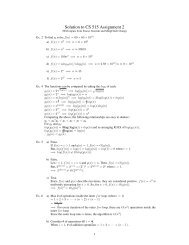Worksheet 14: Introduction to the Dynamic Array - Classes
Worksheet 14: Introduction to the Dynamic Array - Classes
Worksheet 14: Introduction to the Dynamic Array - Classes
You also want an ePaper? Increase the reach of your titles
YUMPU automatically turns print PDFs into web optimized ePapers that Google loves.
<strong>Worksheet</strong> <strong>14</strong>: <strong>Introduction</strong> <strong>to</strong> <strong>Dynamic</strong> <strong>Array</strong>s<br />
Name:<br />
<strong>Worksheet</strong> <strong>14</strong>: <strong>Introduction</strong> <strong>to</strong> <strong>the</strong> <strong>Dynamic</strong> <strong>Array</strong><br />
In Preparation: Read Chapter 5 <strong>to</strong> learn more about abstraction and <strong>the</strong> basic abstract<br />
data types, and <strong>the</strong> dynamic array as a n implementation technique.<br />
Suppose you want <strong>to</strong> write a program that will read a list of numbers from a user, place<br />
<strong>the</strong>m in<strong>to</strong> an array and <strong>the</strong>n compute <strong>the</strong>ir average. How large should you make <strong>the</strong><br />
array? It must be large enough <strong>to</strong> hold all <strong>the</strong> values, but how many numbers will <strong>the</strong> user<br />
enter? A common solution <strong>to</strong> this difficulty is <strong>to</strong> create an array that is larger than<br />
necessary, and <strong>the</strong>n only use <strong>the</strong> initial portion. This is termed a partially filled array.<br />
When you use a partially filled array <strong>the</strong>re are two integer values of interest. First is <strong>the</strong><br />
array length. When discussing partially filled array this<br />
is sometimes termed <strong>the</strong> capacity of <strong>the</strong> array. Second is<br />
<strong>the</strong> current size, that is, <strong>the</strong> amount of <strong>the</strong> array that is<br />
currently being used. The size is generally maintained<br />
by a separate integer variable. If we place <strong>the</strong> values in<strong>to</strong><br />
a structure it will be easier <strong>to</strong> keep <strong>the</strong>m <strong>to</strong>ge<strong>the</strong>r.<br />
struct partFill<strong>Array</strong> {<br />
double data[50];<br />
int size;<br />
};<br />
It is important <strong>to</strong> not confuse <strong>the</strong> size and <strong>the</strong> capacity. For example, in computing <strong>the</strong><br />
sum and average you do not want <strong>to</strong> use <strong>the</strong> capacity:<br />
double average (struct partFill<strong>Array</strong> * pdata) {<br />
double sum = 0.0;<br />
int i;<br />
for (i = 0; i < 50; i++) /* Error–loop using length */<br />
sum = sum + pdata->data[i]; /* Error-uninitialized value */<br />
return sum / 50; /* Error–average is under estimated */<br />
}<br />
Instead, you want <strong>to</strong> use <strong>the</strong> size:<br />
double average (struct partFill<strong>Array</strong> * pdata) {<br />
double sum = 0.0;<br />
int i;<br />
for (i = 0; i < pdata->size; i++)<br />
sum = sum + pdata->data[i];<br />
return sum / pdata->size;<br />
}<br />
An Active Learning approach <strong>to</strong> Data Structures using C 1
<strong>Worksheet</strong> <strong>14</strong>: <strong>Introduction</strong> <strong>to</strong> <strong>Dynamic</strong> <strong>Array</strong>s<br />
Name:<br />
The technique of partially filled arrays works fine until <strong>the</strong> first time that <strong>the</strong> user enters<br />
more numbers than were originally anticipated. When this happens, <strong>the</strong> size can exceed<br />
<strong>the</strong> capacity, and unless some remedial action is taken an array indexing error will occur.<br />
Worse yet, since <strong>the</strong> validity of index values is not checked in C, this error will not be<br />
reported and may not be noticed.<br />
A common solution <strong>to</strong> this problem is <strong>to</strong> use a pointer <strong>to</strong> a dynamically allocated array,<br />
ra<strong>the</strong>r than a fixed length array. Of course, this means that <strong>the</strong> array must be allocated<br />
before it can be used. We can write an initialization routine for this purpose, and a<br />
matching routine <strong>to</strong> free <strong>the</strong> data. Next, we likewise encapsulate <strong>the</strong> action of adding a<br />
new element in<strong>to</strong> a function. This function can check that <strong>the</strong> size does not exceed <strong>the</strong><br />
capacity, and if it does increase <strong>the</strong> length of <strong>the</strong> array (generally by doubling) and<br />
copying all <strong>the</strong> elements in<strong>to</strong> <strong>the</strong> new area. Now <strong>the</strong> user can enter any number of values<br />
and <strong>the</strong> data array will be au<strong>to</strong>matically expanded as needed.<br />
# ifndef EleType<br />
# define EleType double<br />
# endif<br />
struct dy<strong>Array</strong> {<br />
EleType * data;<br />
int size;<br />
int capacity;<br />
};<br />
void dy<strong>Array</strong>Init (struct dy<strong>Array</strong> * da, int iCap) {<br />
da->capacity = iCap;<br />
assert (iCap > 0);<br />
da->size = 0;<br />
da->data = (EleType *) malloc(da->capacity * sizeof(EleType));<br />
assert (da->data != 0);<br />
}<br />
void dy<strong>Array</strong>Free (struct dy<strong>Array</strong> * da) {<br />
free(da->data);<br />
da->data = 0;<br />
da->capacity = 0;<br />
da->size = 0;<br />
}<br />
int dy<strong>Array</strong>Size (struct dy<strong>Array</strong> * da) {<br />
return da->size;<br />
}<br />
void dy<strong>Array</strong>Add (struct dy<strong>Array</strong> * da, EleType newValue) {<br />
if (da->size >= da->capacity)<br />
_dy<strong>Array</strong>DoubleCapacity(da);<br />
da->data[da->size] = newValue;<br />
da->size += 1;<br />
}<br />
An Active Learning approach <strong>to</strong> Data Structures using C 2
<strong>Worksheet</strong> <strong>14</strong>: <strong>Introduction</strong> <strong>to</strong> <strong>Dynamic</strong> <strong>Array</strong>s<br />
Name:<br />
void _dy<strong>Array</strong>DoubleCapacity (struct dy<strong>Array</strong> * da) {<br />
EleType * oldbuffer = da->data;<br />
int oldsize = da->size;<br />
int i;<br />
dy<strong>Array</strong>Init (da, 2 * da->capacity);<br />
for (i = 0; i < oldsize; i++)<br />
da->data[i] = oldbuffer[i];<br />
da->size = oldsize;<br />
free(oldbuffer);<br />
}<br />
The code show above introduces a number of features of <strong>the</strong> C language that you may not<br />
have seen previously. Let us describe some of <strong>the</strong>se here.<br />
EleType. We want <strong>to</strong> create a library of general-purpose functions for managing<br />
collections of various types of elements. In order <strong>to</strong> make our code completely<br />
independent from <strong>the</strong> type of value being s<strong>to</strong>red, we have defined <strong>the</strong> element type using<br />
a symbolic name, EleType. The use of ifdef surrounding <strong>the</strong> definition is a common C<br />
idiom. If <strong>the</strong> user has already provided an alternative definition we will use that,<br />
o<strong>the</strong>rwise <strong>the</strong> symbolic name is given a default value of double.<br />
dy<strong>Array</strong>Init and dy<strong>Array</strong>Free. The C language does not provide a way <strong>to</strong><br />
au<strong>to</strong>matically initialize a structure, such as a construc<strong>to</strong>r does for you in Java or C++.<br />
Instead, programmers must typically write a special initialization function. Programmers<br />
must <strong>the</strong>n remember <strong>to</strong> initialize a structure, and <strong>to</strong> free memory when <strong>the</strong>y are finished<br />
with <strong>the</strong> structure.<br />
struct dy<strong>Array</strong> myData; /* create a new dynamic array */<br />
…<br />
dy<strong>Array</strong>Init (&myData, 50); /* initial capacity is 50 elements */<br />
…<br />
dy<strong>Array</strong>Free (&myData);<br />
Notice that <strong>the</strong> structure is declared as a simple variable. However, because <strong>the</strong> functions<br />
require a pointer, <strong>the</strong> address-of opera<strong>to</strong>r (<strong>the</strong> ampersand) is used <strong>to</strong> produce a pointer <strong>to</strong><br />
<strong>the</strong> structure.<br />
da->size. Whenever you use a pointer you must make it clear when you are referring <strong>to</strong><br />
<strong>the</strong> pointer itself and when you are referring <strong>to</strong> <strong>the</strong> value it points <strong>to</strong>. Normally a pointer<br />
value must first be dereferenced, using <strong>the</strong> * opera<strong>to</strong>r, <strong>to</strong> indicate that you mean <strong>the</strong> value<br />
it points <strong>to</strong>, not <strong>the</strong> pointer itself. Accessing a field in a structure referred <strong>to</strong> by a pointer<br />
could be written using <strong>the</strong> dereference opera<strong>to</strong>r, as in (*da).size. However, this<br />
combination of pointer dereferencing and field access occurs so frequently that <strong>the</strong><br />
designers of C provided a convenient shorthand.<br />
malloc. The function malloc is used <strong>to</strong> perform memory allocation in C. The argument<br />
is an integer indicating <strong>the</strong> number of bytes requested. In order <strong>to</strong> determine how many<br />
bytes are required for each element <strong>the</strong> function sizeof is invoked. Multiply <strong>the</strong> number<br />
An Active Learning approach <strong>to</strong> Data Structures using C 3
<strong>Worksheet</strong> <strong>14</strong>: <strong>Introduction</strong> <strong>to</strong> <strong>Dynamic</strong> <strong>Array</strong>s<br />
Name:<br />
of elements you need by <strong>the</strong> size of each element, and you have a block of memory that<br />
can be used as an array.<br />
assert. The malloc function will return zero if <strong>the</strong>re is insufficient memory <strong>to</strong> satisfy a<br />
request. The assert macro will halt execution with an error message if its argument<br />
expression is not true. Assertions can be used any time a condition must be satisfied in<br />
order <strong>to</strong> continue.<br />
free. The function free is <strong>the</strong> opposite of malloc. It is used <strong>to</strong> return a block of memory<br />
<strong>to</strong> <strong>the</strong> free s<strong>to</strong>re. Such memory might later be reused <strong>to</strong> satisfy a subsequent malloc<br />
request. You should never use malloc without knowing where and when <strong>the</strong> memory<br />
will subsequently be freed.<br />
Defensive programming. When <strong>the</strong> memory is released in <strong>the</strong> function dy<strong>Array</strong>Free <strong>the</strong><br />
size and <strong>the</strong> capacity are both set <strong>to</strong> zero. This ensures that if a subsequent attempt is<br />
made <strong>to</strong> insert a value in<strong>to</strong> <strong>the</strong> container, <strong>the</strong>re will not be an attempt <strong>to</strong> index in<strong>to</strong> an<br />
already deleted array. Ano<strong>the</strong>r example of defensive programming occurs in <strong>the</strong> function<br />
_dy<strong>Array</strong>DoubleCapacity. What happens if <strong>the</strong> current capacity is zero when this<br />
function is called? One response would be <strong>to</strong> use assert, and halt execution if this is true.<br />
Ano<strong>the</strong>r approach, taken here, is <strong>to</strong> make <strong>the</strong> function do something reasonable in this<br />
situation, namely <strong>to</strong> create an array with a capacity of two elements.<br />
dy<strong>Array</strong>Size. Since <strong>the</strong> size field is s<strong>to</strong>red as part of <strong>the</strong> dynamic array structure <strong>the</strong>re<br />
really is no need for this function, since <strong>the</strong> user can always access <strong>the</strong> field directly.<br />
However, this function helps preserve encapsulation. The end user for our container need<br />
not understand <strong>the</strong> structure definition, only <strong>the</strong> functions needed <strong>to</strong> manipulate <strong>the</strong><br />
collection.<br />
_dy<strong>Array</strong>DoubleCapacity. An underscore is treated as a legal letter in <strong>the</strong> C language<br />
definition for <strong>the</strong> purposes of forming identifiers. There is a common convention in <strong>the</strong> C<br />
programming community that function names beginning with an underscore are used<br />
“internally”, and should never be directly invoked by <strong>the</strong> end user. We will follow that<br />
convention in our code. The function _dy<strong>Array</strong>DoubleCapacity is can be called by<br />
dynamic array functions, but not elsewhere.<br />
Note carefully <strong>the</strong> order of operations in <strong>the</strong> function _dy<strong>Array</strong>DoubleCapacity. First,<br />
<strong>the</strong> new array is created. Next, <strong>the</strong> old values are copied in<strong>to</strong> <strong>the</strong> new array. The free<br />
statement <strong>the</strong>n released <strong>the</strong> old memory. Finally, <strong>the</strong> pointer is changed <strong>to</strong> reference <strong>the</strong><br />
new array.<br />
In order <strong>to</strong> allow a dynamically allocated array <strong>to</strong> be used in <strong>the</strong> same fashion as a normal<br />
array, we need functions that will get and set values at a given position. We can also<br />
make our function more robust than <strong>the</strong> regular C array by checking index positions.<br />
Complete <strong>the</strong> implementation of <strong>the</strong> following functions. Use assert <strong>to</strong> check that index<br />
positions are legal.<br />
An Active Learning approach <strong>to</strong> Data Structures using C 4
<strong>Worksheet</strong> <strong>14</strong>: <strong>Introduction</strong> <strong>to</strong> <strong>Dynamic</strong> <strong>Array</strong>s<br />
Name:<br />
EleType dy<strong>Array</strong>Get (struct dy<strong>Array</strong> * da, int position) {<br />
}<br />
void dy<strong>Array</strong>Put (struct dy<strong>Array</strong> * da, int position, EleType value) {<br />
}<br />
Write <strong>the</strong> function swap, which will exchange <strong>the</strong> values in two positions of a dynamic<br />
array. We will use this function in later chapters.<br />
void dy<strong>Array</strong>Swap (struct dy<strong>Array</strong> * da, int i, int j) {<br />
}<br />
An Active Learning approach <strong>to</strong> Data Structures using C 5

















